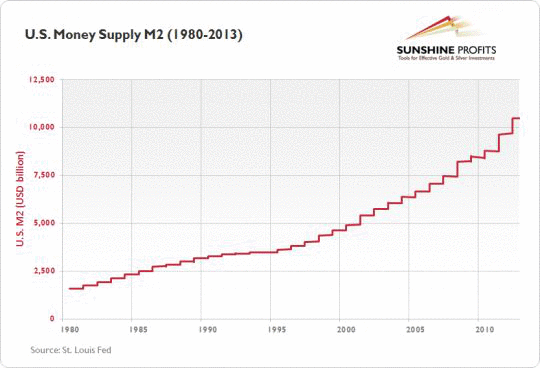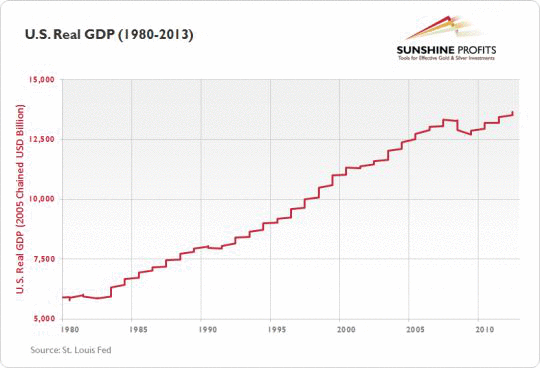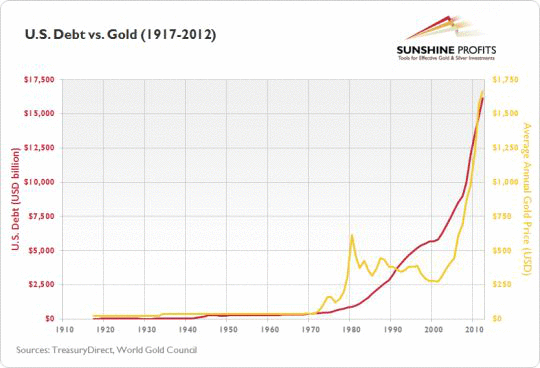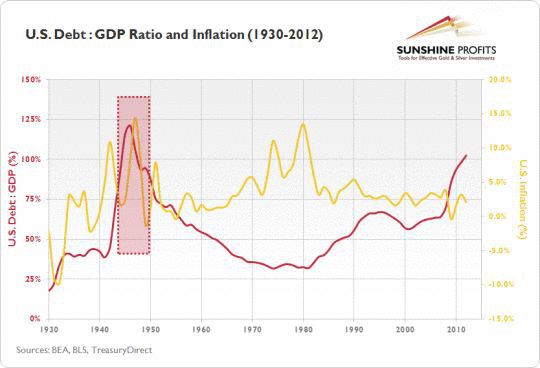Gold and Quantitative Easing: Inflation All Over Again?
Commodities / Gold and Silver 2013 Jan 31, 2013 - 07:56 AM GMTBy: P_Radomski_CFA
 Perhaps you have heard that the Fed is printing money to get out of the crisis and that such actions cannot possibly end other than in even more money being printed and in the dollar losing its ability to buy you tangible assets. In our essay on gold and the dollar collapse we pointed out that since 1970 the debt numbers have gone up more than 40-fold (!). In 2002, future Fed chairman Ben Bernanke noted that "the U.S. government has a technology, called a printing press (or today, its electronic equivalent), that allows it to produce as many U.S. dollars as it wishes at no cost." In keeping with these words, Bernanke has played an important role in the introduction of three rounds of what is known today as quantitative easing (QE) - programs expanding the money supply beyond the usual. The bill for QEs is $2.25 trillion and counting. As of January 17, 2013, U.S. debt totaled $16.4 trillion. These extraordinary numbers call for a deeper analysis and today we focus on what QE actually is.
Perhaps you have heard that the Fed is printing money to get out of the crisis and that such actions cannot possibly end other than in even more money being printed and in the dollar losing its ability to buy you tangible assets. In our essay on gold and the dollar collapse we pointed out that since 1970 the debt numbers have gone up more than 40-fold (!). In 2002, future Fed chairman Ben Bernanke noted that "the U.S. government has a technology, called a printing press (or today, its electronic equivalent), that allows it to produce as many U.S. dollars as it wishes at no cost." In keeping with these words, Bernanke has played an important role in the introduction of three rounds of what is known today as quantitative easing (QE) - programs expanding the money supply beyond the usual. The bill for QEs is $2.25 trillion and counting. As of January 17, 2013, U.S. debt totaled $16.4 trillion. These extraordinary numbers call for a deeper analysis and today we focus on what QE actually is.
The beginning of the economic crisis is usually linked with the date of September 15, 2008 when the U.S.-based investment bank Lehman Brother filled in for bankruptcy. Lehman Brothers went down with a bang, sending shockwaves through the financial markets and effectively beginning the global banking crisis. Lehman went bankrupt because of its bets on U.S. mortgages which had gone bad. When it became apparent that Lehman would not meet its obligations, everybody in the markets began to fear that everybody else could have excessive exposure to the housing market by holding assets linked to the performance of that market on their balance sheets. The market "dried up" - the lending between financial institutions effectively came to a halt and there was no liquidity in the market. In such an environment the financial markets ceased to channel funds to businesses and the credit market froze. Without credit, companies were not able to operate in a regular way. Such a disruption added to the problems stemming from the declining house prices. So, the lack of liquidity in the financial markets translated into a recession.
Facing the possibility of the further havoc, the U.S. government set the Troubled Asset Relief Program (TARP) into motion under which the U.S. Treasury was buying assets linked to the mortgage market in order to pump money and, therefore, liquidity into the banking system. TARP was a prelude to QE.
Under usual conditions, when the economy is struggling and there is not enough credit available, the central bank can lower the interest rate in order to make credit cheaper and more accessible. A lower central bank interest rate translates into lower interest paid by companies to commercial banks. It has also an adverse effect on savings - it becomes less profitable to keep your money in the bank since the interest you get is also lower. So, central banks tend to lower interest rates in hope of making credit cheaper, stimulating consumers to spend more and companies to invest more. Following the events of September 2008, the Fed brought its federal funds rate close to 0%. However, even combined with TARP, this did not bring the expected liquidity to the market.
Even though bailouts may have prevented the economy from slipping into chaos, the economic environment appeared to be deflationary. This means that with inflation close to 0%, the Fed feared a scenario in which the economy would actually experience deflation. Deflation results in falling prices. At first sight it may be hard to recognize why this would be harmful for the economy. To understand that, we need to consider that falling prices put off people from spending their money. After all, if goods are getting cheaper and cheaper, why buy a car now and not in several months when it costs less than today? Such thinking limits spending and the economy starts to wobble since the producers cannot find enough buyers for their goods. This limits output which, in turn, limits growth. Such an extremely simplified picture shows you why deflation is an unfavorable scenario. Generally, in the long run the market would be expected to fix itself - when prices get low enough, somebody would finally buy and prices would start to rise thus fueling growth of prices and economic activity. However, this is not in tune with what the Powers That Be are concerned with - they don't want to have to tell voters that they have to wait a bit before things get better - they want to show that they can make things better right away.
If you consider that the interest rate can go only as low as 0%, you will come to the conclusion that in late 2008 the Fed practically lost its ability to stimulate the credit market and avoid deflation by lowering interest rates. At that time the Fed wanted to achieve a number of goals, including delivering liquidity and increasing spending to boost up the economy. Since the interest rates were already close to 0%, it adopted an unconventional policy. Namely, it started buying mortgage backed securities (MBS, assets linked to the performance of the real estate market) and Treasury securities. The gist of this approach was that the purchases were covered with newly created money.
Technically, the Fed did not print any new dollars. It took in MBSs and bonds from commercial institutions (e.g. banks) in return for acknowledging a claim against it. The commercial banks and other institutions could use that claim to lend out additional amounts of money. Fed's idea was that buying assets would drive their prices up and simultaneously drive bond yields down (bond yields fall when bond prices rise and vice versa). Lower bond yields would be accompanied by lower interest rates and would make it easier for companies to find access to credit. Low bond yields would also make bond investments unprofitable for those willing to gain stream of income from them and force investors to switch to other assets, mainly to the stock market. This would, in turn, help to channel funds to U.S. companies and give the economy an impulse to grow. All of this would result in higher prices (inflation) and in increased economic activity.
The plan seemed quite simple - more lending, more money, more spending, more growth. There are, however, painful parts to this story. First of all, even though no additional notes were printed, the overall action increased the amount of money in the economy. No more goods were produced immediately but there were considerable amounts of freshly created electronic money hoarded in the accounts of commercial banks. This is potentially dangerous since it is obvious that creating more money, be it paper or electronic, will highly likely lead to inflation.
The chart below presents the expansion of the money supply in the U.S. as measured by the M2 aggregate (one of the definitions of money).

As you can see, the money supply in the U.S. is ever increasing just as it is in all the other developed economies all over the world. Since January 2008, it has increased by 40.4%. Conventional economic theories have it that the money supply ought to be increased roughly at the same pace as the growth of the economy. During the same period, the economy grew by 2.9% which is also displayed on our next chart.

This chart suggests that the U.S. economy may be getting back on the growth trajectory. Such a conclusion is not necessarily supported by other economic data, like unemployment numbers. However, it seems that in terms of real GDP the U.S. economy is slowly moving forward. Does this actually mean that the QEs are doing the trick? The best answer we can get to that question has been given quite bluntly by the BBC economics editor Stephanie Flanders: "Quantitative easing may well have saved the economy from a credit-led depression. We will never know." But we definitely know what's left over from the QEs. Take a look at the chart below which comes from our essay on gold and the dollar collapse.

In the abovementioned essay, we wrote the following:
It belongs to common sense that you can't borrow money forever. Economics has a lot of intricacies and can be quite complicated at times but the basic rules are very simple. You borrow, you have to pay back.
Right now, the Fed's balance sheet is becoming inflated to a point at which it may start to worry even its members. A point of view that it may be appropriate to end QE under several conditions was expressed by James Bullard, president of the St. Louis Fed, who said:
If the economy performs well in 2013, the Committee will be in a position to think about going on pause. If it doesn't do very well then the balance sheet policy will probably continue into 2014.
It turns out, however, that the markets do not necessarily believe in QE ending as soon as this year. A recent survey by CNBC shows that market analysts are of the opinion that Fed will continue to buy assets aggressively and are divided as to when the purchases may end. A similar stance was presented by former Fed vice chair Alan Blinder who argued:
It's never too soon to start thinking about it [but] I'd be very surprised if Fed even starts on its exit starting in 2013. I wouldn't even bet on 2014. (Yahoo!) So, it seems that we might not see QE ending this year or even next year.
So, it seems that there is a lot of uncertainty linked to the growing debt pile but an economic recovery might as well be happening right in front of our eyes. What does it all mean for precious metals investors? The next chart might help clear that up.

This chart shows you the U.S. debt to GDP ratio along with the official rate of inflation. As of 2012, with a debt to GDP ratio of 102.5%, the U.S. is still quite far from where the ratio stood at in 1946, namely from 121.3%. We see that following the peak of 1946, the ratio sank considerably quickly (the red box in the chart). One of the key factors that made it possible was inflation. The annual inflation numbers for 1946, 1947 and 1948 read 8.3%, 14.4% and 8.1%.
It is worth noting that inflation started off for good after the debt to GDP ratio peaked. So, the inflation does not have to be obvious until the end of the debt expansion process. Translating that into the current economic situation: the mere fact that there has been no QE-related inflation so far does not mean that there automatically will be no inflation in the future, after the QE has ended. And the inflationary scenario seems all the more plausible since the government has only a number of ways to decrese the debt pile: economic growth, taxes and inflation (to simplify a bit). Growth is hard to achieve only through policy decisions, the taxpayers strongly oppose any new taxes, so it seems that the easiest way is to inflate the debt away, since a rise in inflation is not easily recognized by the markets (at leas at the very beginning). Naturally, 1946-48 was very different from today but a hike in inflation after the end of QE is still possible. Now, imagine official inflation numbers reading 8% or even 15% just as they did in 1946-48. Such a scenario would be extremely bullish for gold.
To sum up, even if the economy gets back on track, there is still a high probability of a hike in inflation which would bring the real debt burden down but could be very bullish for precious metals. If the economy doesn't improve decisively, there is still a risk of further increases in the money supply, which could fuel uncertainty and translate into higher gold prices. So, no matter if QE saved the economy or just burdened it, it may significantly contribute to the gold bull market. It seems that it already has.
If you have enjoyed this essay, please check our free gold newsletter which covers both gold fundamentals, market timing and other precious metals related topics. If you're an active investor or just begin your adventure with gold and silver, you may want to see our essay on how to build your gold and silver portfolio.
Use the following link to sign up for a free, no-obligation trial of our Premium Service and read the complete version of this study that is over 10 times bigger. You'll also receive Market Alerts when things "get hot" on the precious metals market and when the trial expires, you'll start receiving our free newsletter. Additionally, you will also receive 12 gold best practice emails.
Thank you for reading. Have a great and profitable week!
Przemyslaw Radomski, CFA
Founder, Editor-in-chief
Gold & Silver Investment & Trading Website - SunshineProfits.com
* * * * *
About Sunshine Profits
Sunshine Profits enables anyone to forecast market changes with a level of accuracy that was once only available to closed-door institutions. It provides free trial access to its best investment tools (including lists of best gold stocks and best silver stocks), proprietary gold & silver indicators, buy & sell signals, weekly newsletter, and more. Seeing is believing.
Disclaimer
All essays, research and information found above represent analyses and opinions of Przemyslaw Radomski, CFA and Sunshine Profits' associates only. As such, it may prove wrong and be a subject to change without notice. Opinions and analyses were based on data available to authors of respective essays at the time of writing. Although the information provided above is based on careful research and sources that are believed to be accurate, Przemyslaw Radomski, CFA and his associates do not guarantee the accuracy or thoroughness of the data or information reported. The opinions published above are neither an offer nor a recommendation to purchase or sell any securities. Mr. Radomski is not a Registered Securities Advisor. By reading Przemyslaw Radomski's, CFA reports you fully agree that he will not be held responsible or liable for any decisions you make regarding any information provided in these reports. Investing, trading and speculation in any financial markets may involve high risk of loss. Przemyslaw Radomski, CFA, Sunshine Profits' employees and affiliates as well as members of their families may have a short or long position in any securities, including those mentioned in any of the reports or essays, and may make additional purchases and/or sales of those securities without notice.
Przemyslaw Radomski Archive |
© 2005-2022 http://www.MarketOracle.co.uk - The Market Oracle is a FREE Daily Financial Markets Analysis & Forecasting online publication.



